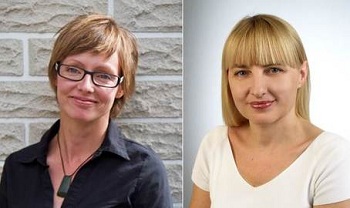May 3 2012
BioNavis Ltd. announces the winners of the International Multi-Parametric Surface Plasmon Resonance Contest.
 Dr. Jenny Malmström (Left), Postdoctoral Fellow at the Polymer Electronics Research Centre, University of Auckland (NZ) and Dr. Barbara Jachimska (Right), Associate Professor at the J.Haber Institure of Catalysis and Surface Chemistry, Polish Academy of Sciences, Cracow.
Dr. Jenny Malmström (Left), Postdoctoral Fellow at the Polymer Electronics Research Centre, University of Auckland (NZ) and Dr. Barbara Jachimska (Right), Associate Professor at the J.Haber Institure of Catalysis and Surface Chemistry, Polish Academy of Sciences, Cracow.
The winners are Dr. Jenny Malmström, Postdoctoral Fellow at the Polymer Electronics Research Centre, University of Auckland (NZ) and Dr. Barbara Jachimska, Adjunct Professor at the J.Haber Institure of Catalysis and Surface Chemistry, Polish Academy of Sciences, Cracow. The winning proposals are both based on assessing new types of active polymers. In Auckland, the polymers will be controlled electrically, while in Cracow, another type of polymers will be controlled by ionic strength and pH.
In electrically switchable polymers, the surface conductivity can be controlled between conducting and insulating states. In ionically-controlled polymers, the hydration and the shape of the surface can be controlled. The applications of such smart surfaces include for instance solar, biosensors, smart implants, drug delivery, toxicology and others.
The scientific committee consisting of Dr. Janusz Sadowski (Vice President, R&D BioNavis), Prof. Orlando Rojas (North Carolina State University, USA), Prof. Jukka Lekkala (Tampere University of Technology, Finland) and Dr. Ulf Jönssön (Biacore founder and SPR expert, Sweden) has unanimously selected the proposals of Dr. Jenny Malmström, Postdoctoral Fellow, Polymer Electronics Research Centre, University of Auckland (NZ) and Dr. Barbara Jachimska, Adjunct Professor, J.Haber Institure of Catalysis and Surface Chemistry, Polish Academy of Sciences as the winners of the Multi-Parametric Surface Plasmon Resonance contest organized by BioNavis Ltd.
The winners are awarded the SPR Navi instrument and consumables to perform the proposed studies. Dr. Malmström will be working on Studies of Electrically Switchable Surfaces and Related Protein Adsorption and Dr.B.Jachimska will be working on the conformation process of poly(amidoamine)-PAMAM dendrimers.
A word from the inventor, Dr. Janusz Sadowski
What can you say about the winning proposals?
"It is interesting to see that both of the winning proposals are dealing with switchable surfaces - one using electrical switching and the other one using ionic strength and pH. Both of them take advantage of novel possibilities, but from different angle - Dr. Malmström utilizing multiple wavelengths to determine conformational changes including thickness and refractive index and MP-SPR with electrochemistry, Dr. B. Jachimska utilizing measurements in air and in water and previous QCM-D measurements," says Dr. Janusz Sadowski.
Was it difficult to make the choice?
"All of the proposals that were received by the dead-line and meeting all of the criteria were ranked according to their originality, novelty, realism, expected results in defined time, group support and publication plan. Once all of the members had submitted their ranking, it was quite clear that the top two proposals are difficult to choose from and so we have decided to award two prizes this year. I am really looking forward to seeing the results of the work."
A word from the winners, Dr. Jenny Malmström and Dr. Barbara Jachimska
Dr. Malmström, what are your first reactions and what are your expectations?
"I'm very excited! Looking forward to when the instrument arrives and we can start our measurements. I plan on combining the information from different wavelengths of MP-SPR to
evaluate for the first time switchability and protein adsorption of novel polymers for control of cell adhesion, proliferation and differentiation."
Dr. Malmström, where will we see your surfaces in future?
"In 10-20 years I can envision that our electrically switchable surfaces are commonly used within the field of tissue engineering to produce cells or functional tissues for implantation. Our surfaces will be able to provide a range of different stimuli and display of functional groups upon electrical stimuli to steer cellular behavior and will finally allow gentle release of the cells or tissue."
Dr. B. Jachimska, what do you expect to see with MP-SPR?
"I believe that the combination of MP-SPR and QCM will enable me to evaluate parameters characterizing the dendrimers monomolecular films, in particular, the degree of the dendrimers hydration and increase in the molecule volume, in dependence on pH and the ionic strength. By following time changes in the film thickness, kinetics of the adsorption process will be characterized. Performing the SPR measurements on polarized Au slides will allow me to evaluate the role of electrostatic interactions in the adsorption. Following time changes of the film thickness upon changing pH from alkaline to acidic will give us the insight into the kinetics of the swelling process."
About Multi-Parametric Surface Plasmon Resonance
MP-SPR is a novel approach to the half-a-century old optical phenomenon Surface Plasmon Resonance (SPR). For the last 20 years SPR has been predominantly used for biomolecular interaction analysis. MP-SPR broadens the application range also to biophysical studies, such as measurements of absolute refractive indices and formed layer thicknesses, and biomaterials studies, such as ceramic and polymer coating characterizations and biocompatibility studies. MP-SPR is based on a optical arrangement that enables measurements on a number of sensor coatings that cannot be measured with traditional SPR. Apart from traditional hydrogel based biosensor coatings, a wide range of different sensor surfaces are also possible to use, such as different metals (Au, Ag, Al, Cu, Pt), polymers (PS, PEO, PMMA, cellulose), and ceramics (Al2O3, SiO2, TiO2). The instrument is compatible with other equipment, in example HPLC and electrochemisty, which enables much more information to be gathered from the same sample simultaneously.